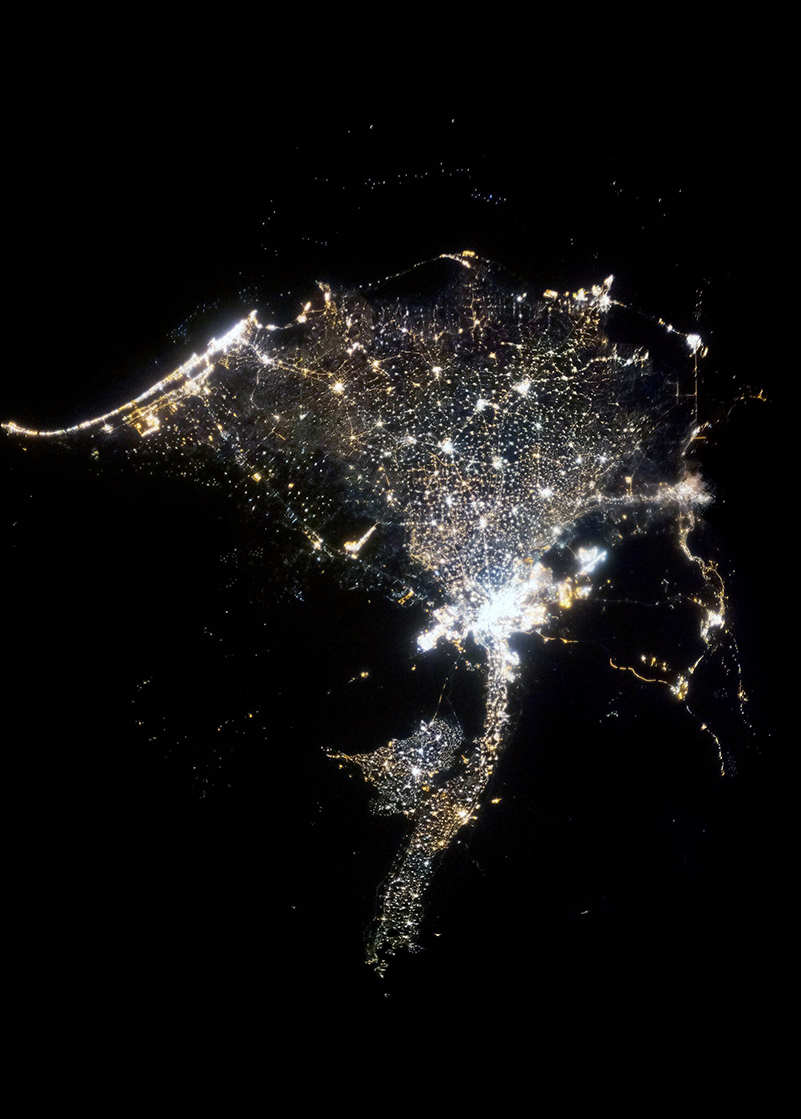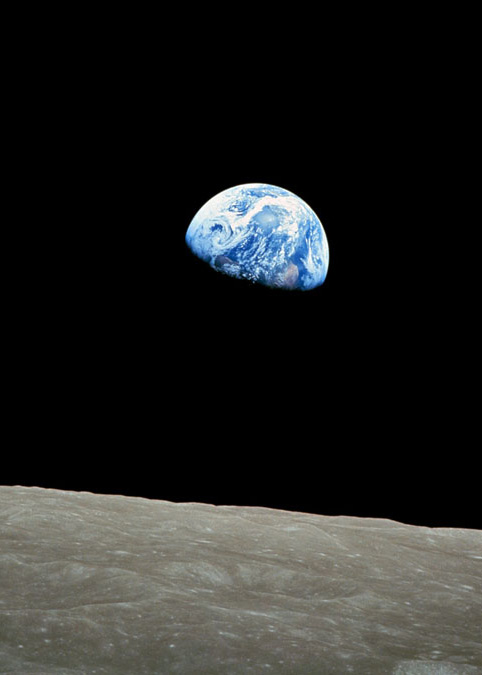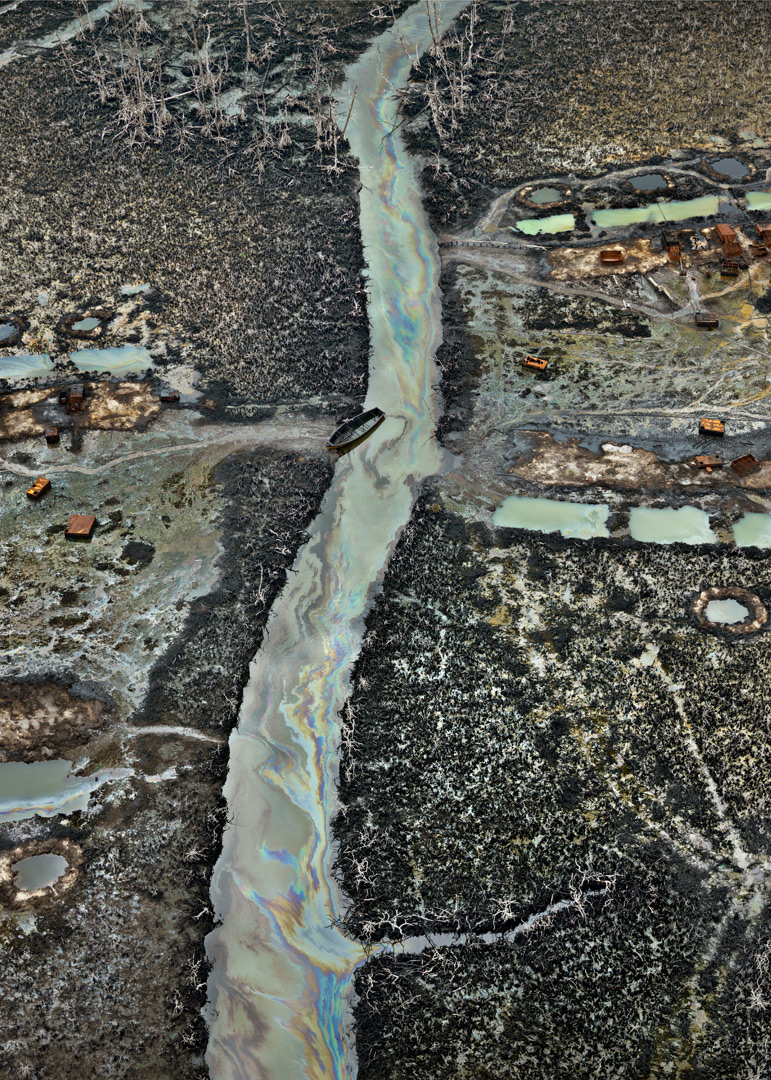
David Abram is a cultural ecologist, geophilosopher, and the founder and creative director of the Alliance for Wild Ethics (AWE). His books include Becoming Animal: An Earthly Cosmology and The Spell of the Sensuous: Perception and Language in a More-than-Human World. David recently served as the Senior Fellow in Ecology and Natural Philosophy at Harvard Divinity School.
Studio Airport, founded by Bram Broerse and Maurits Wouters, is an interdisciplinary design studio that ventures out into the cultural ether to forage for anomalies, creating work that spans art, culture, science, and ecology. In addition to Emergence Magazine, their creative partners include the Design Museum, See All This Art Magazine, Slowness, Normal Phenomena of Life, and Sapiens Magazine. They are master tutors at the Design Academy Eindhoven and were recognized as European Agency of the Year 2024 by the EDA.
Reflecting on our undying urge to recreate a primal experience of intimacy with the surrounding world, David Abram offers notes on technology and animism in an age of ecological wipeout.
A hallmark of the puzzling era we’re now living through is a remarkable juxtaposition of two apparently contrary trends. In many social circles, there exists a buoyant sense of possibility, an upbeat and expectant optimism with regard to the near and long-term future. Yet in other societal spheres, a spreading despondency weighs folks down whenever they contemplate our collective future, an overwhelming hopelessness that interferes with their ability to even envision a livable future a generation or two from now.
These very different collective moods are generally—although not always—carried by different groups of people. Those who spend a majority of their time engaged with new media, or who rarely venture outside the bustling life of our large cities, are witness and sometimes party to the unceasing creativity that brings dazzling new forms of communication, association, and entertainment into our lives with unprecedented rapidity. When reflecting upon the future, such persons are often filled with a sense of open and unbounded possibility. The prospects seem to them endless; many intuit that new technologies promise ever greater freedom for our kind. They anticipate, with a sense of wonder bordering on awe, the advent of ever more complex robotics, and the ability of nanotechnology to eliminate many of the world’s problems. They look forward to the eradication of disease and the chance for humankind, augmented by or in tandem with new technologies, to determine its own future and to spread, soon enough, to other planets, and beyond.
Then there are those who spend much of their time outside the large urban and suburban centers, or at least out of doors within those cities, and hence in direct relation to the wider-than-human collective of earthly life; such individuals are often beset by a deepening malaise. Attending to their faltering crops or noting the dwindling snowpack on the mountains above town, puzzled by the altered migration patterns of birds whose flocks no longer return to the region, wondering at the blight that’s shrinking the leaves on the forest trees, and alarmed by the northward advance of yet another insect-borne illness infecting more and more friends each year, many find themselves in a deepening state of shock regarding the mounting signs of ecological breakdown and runaway climate change. They’ve allowed a few years for this recent hiatus in the seasonal cycle to right itself; but when the expected correction fails to materialize—when the patterns they’ve known from childhood, and from their grandparents’ childhoods, never reassert themselves—then an uncanny form of anxiety begins to darken their dreams and leave a bitter taste whenever they swallow. It’s an anxiety that seems less about their own well-being or even their children’s than about the whole of the breathing landscape that’s given rise to and sustained every facet of human life until now. Suddenly this terrain, the taken-for-granted ground of our lives and the enabling backdrop for all our conviviality, seems unsure and unstable.
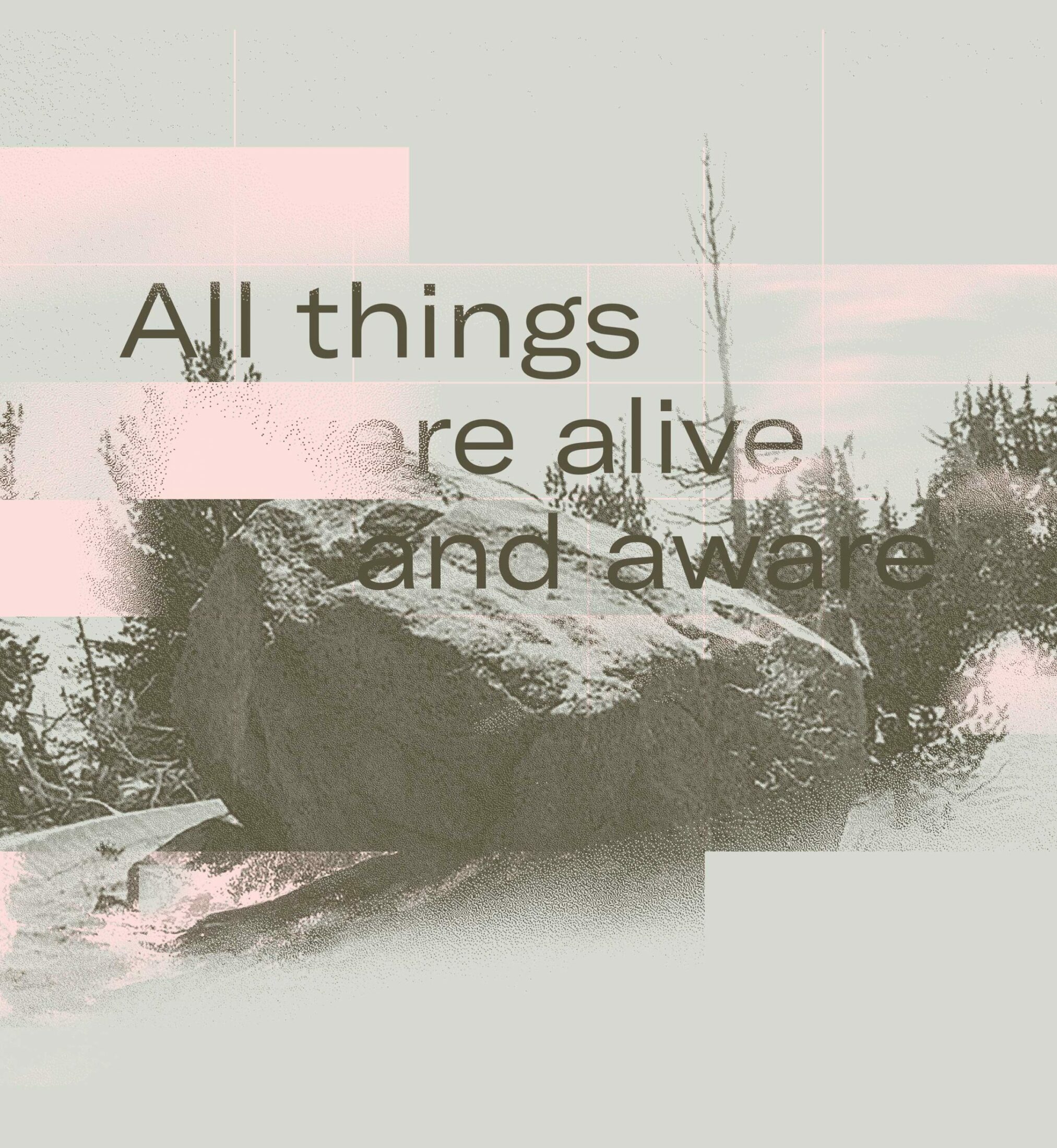
These two divergent outlooks are not always carried by different groups of people; they can also be felt by the very same individuals at different moments of their life, or even at different moments within a day. This is especially true now that almost every vocation involves engaging to some extent with digital technology and being exposed to the dynamism of its ongoing evolution. And even those who are entirely immersed in the hubbub of urban life, or wholly enmeshed in online forms of interaction, can no longer avoid coming into contact with news of ecological calamity; even if their city has not yet succumbed to rolling power outages, or had its streets inundated by rising floodwaters, they still encounter images of intensifying floods and never-before-seen hurricane winds as those images and video clips bounce around the digital ether. The coverage of news regarding the more-than-human natural world by modern media remains crazily miniscule relative to the coverage of exclusively human goings-on (of human violence and personal scandals), yet not even the most blinkered news organizations can avoid mentioning cyclones and runaway forest fires when these threaten large swaths of the human population.
And so we all come into contact with both trends, and some folks are afflicted—although at different times—by both moods. At one moment, they feel the shuddering horror of the extinction spasm now gripping our planet, at another they’re enlivened by giddy optimism, inspired by the techno-utopian zeal that courses like a river of money through the world of software development, social network apps, and high-tech innovation. In those who are regularly captured by both states of mind, we might expect to see these contrary moods begin to blur and blend into something new and insightful—an understanding of how these two intensifying dynamics actually inform one another. But such is not the case; the two states of mind are so incommensurable that each seems unable to communicate with the other, and so such persons are buffeted back and forth, sometimes afloat with technological optimism, at other times struck dumb with a foreboding that seems to intensify with each passing season.
How, then, can we make sense of this curious juxtaposition? What are the actual relations between these two apparently contrary trends—deepening ecological catastrophe (and the ease with which it provokes the apocalyptic imagination) and rapidly burgeoning technology (with its attendant technological utopianism)?
Is it possible, for instance, that the many new and onrushing technologies currently bursting upon the scene are arriving just in time to avert ecological catastrophe—indeed, have they been somehow called into being by the unprecedented stress in which our planet now finds itself? Or, on the contrary, is the intensive mining and manufacture necessary to the new technologies a key factor in the emergence of these worldwide environmental stresses? Obviously, the burning of fossil fuel needed to power an earlier generation of technologies has been a primary factor in the onset and intensification of climate destabilization, as the extraction of such fuel played a large role in the degradation of innumerable local ecosystems, and the consequent damage to other species. Still, we may wonder: Does the emergence of Big Data made possible by digital technology now enable research that promises to alleviate those very stresses on the planet? Is not the widespread use of ever more complex computer simulations now hastening the deployment of sustaining ways of harvesting energy that might enhance, rather than deplete, the integrity of the waters, the winds, and the soils?
Without doubt there exist a complex range of relationships between the rapid deterioration of ecological integrities and the rapid growth of digital technologies. In this essay I wish to focus primarily on some unnoticed perceptual dynamics at play within and between these two contrary trends.
My work has long been concerned with the human propensity for animistic engagement with every aspect of the perceptual world.1 For most traditionally oral, indigenous cultures that we know of, any and every phenomenon is potentially animate; everything moves. All things are felt to have their own pulse, their own inner spontaneity or dynamism. All things have agency, the capacity to act—although some things, like trees, rocks, or mountains, clearly move much slower than other things, like bears or dragonflies. Such styles of perception show themselves in exceedingly different ways throughout diverse indigenous traditions, yet Western ethnologists in the late nineteenth and early twentieth centuries could not help but notice this curious commonality among the divergent tribes they lived with and sometimes managed to learn from. The members of such cultures seemed to respond to their surroundings as though all things were alive and (at least potentially) aware. Further, from this animistic perspective, it seemed that all things were felt to be expressive; all things had the power of meaningful speech (although, of course, very few of them spoke in words).
The conventional interpretation of such ways of encountering the world, among social scientists, has held that traditional, “tribal” persons are confusedly projecting human attributes—such as life and consciousness—into nonhuman and ostensibly inanimate phenomena. I wish to argue, however, that animistic perception is utterly normal for the human organism, a kind of default setting (to use a technological metaphor) for our species; that in the absence of intervening technologies, the human senses spontaneously encounter the sensorial surroundings as a field of sensitive and sentient powers. Our most immediate experience of the earthly world, and of the myriad bodies that compose this world, is of a multiply animate cosmos wherein no thing is definitively void of expressive agency, or life.
To be sure, such participatory experience is very far from our current feel for things in the midst of contemporary, hyper-modern civilization. Few people today, when they’re cycling past a stand of oaks, sense that those trees are sensing them; we don’t feel the breeze gusting around us as a sensitive and sentient presence, and upon arriving at our place of work and settling down to the day’s tasks, we don’t concern ourselves that the chairs we sit in register our presence, or that the walls of the room are affected by our actions.
It’s commonly assumed that such animistic intuitions have vanished from much of the civilized world—initially dispelled by the spread of the great religious traditions, and then more thoroughly banished by the spread of the various sciences—and hence that such participatory experience is largely alien to modern humankind in the twentieth and twenty-first centuries. My own research suggests otherwise. Not only have diverse aboriginal traditions continued to unfold and to contribute elements of their own deeply participatory lifeways to the colonial powers that tried to subjugate or subsume them, but the dominant, Western culture has itself been deeply shaped by intensely participatory, animistic forms of experience.
For animism—the instinctive experience of reciprocity or exchange between the perceiver and the perceived—lies at the heart of all human perception. While such participatory experience may be displaced by our engagement with particular tools and technologies, it can never entirely be dispelled. Rather, different technologies tend to capture and channel our instinctive, animistic proclivities in particular ways.
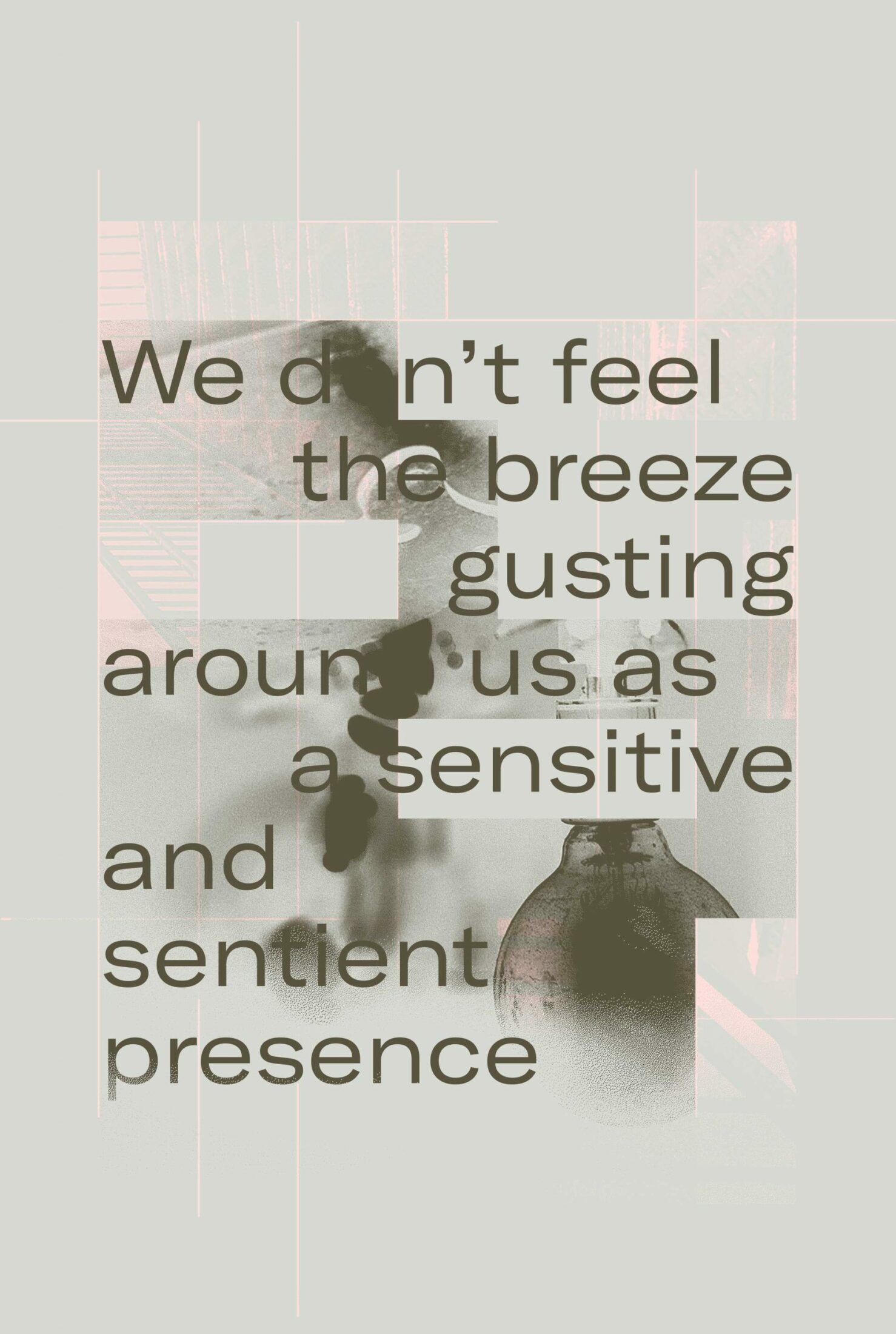
One ancient technology that conditioned and opened the way for countless later technologies is today so ubiquitous that we tend to take it for granted and forget that it is indeed a technology: the alphabet. The alphabet was foundational to many of the collective habits and cognitive patterns radiating from the Mediterranean throughout Europe, and ultimately the Americas. It is thoroughly implicated in the vast influence of all three of the monotheistic traditions—the Religions of the Book—and was formative for the birth of Western philosophy in ancient Athens. Much later, with the advent of the printing press, the alphabet catalyzed the Protestant Revolution and the European Enlightenment, enabling the development and spread of Western science. Indeed this remarkable technology has so thoroughly informed the thought style of this hemisphere that everything commonly termed Western civilization should more precisely be spoken of as alphabetized civilization.
When most people learn the extent to which phonetic literacy figured in the rise of monotheism, and then the extent to which the proliferation of literacy made possible by the printing press sparked both the Protestant Reformation and the Scientific Revolution, they conclude—as indeed most scholars have concluded—that reading and writing enable a form of reason that rapidly loosens and breaks free from the superstitious, animistic beliefs to which non-writing, oral cultures are presumably prone (and to which most citizens of European and American civilization are presumably immune). I want to argue, however, that alphabetic literacy can best be understood as a highly concentrated form of animism.
Consider the refusal of our indigenous forebears (as well as many indigenous folks today) to assume that language is an exclusively human power; ponder their assumption that all things have the potential for meaningful utterance. Contemplate the propensity of oral persons to find themselves being addressed, or spoken to, by various other beings in the sensible surroundings: a raven, or a river, or the chattering leaves of an aspen tree. To the animistic frame of mind, any sound can be a voice, any movement can be a gesture laden with expressive intent.
Now, consider the act of reading the morning newspaper. Upon waking, you stumble into the kitchen, brew a cup of coffee, open the paper and focus your eyes upon those bits of ink arrayed in lines across the page. Straightaway you hear voices—the phantom voice of the journalist, or the voices of the German chancellor and the Bolivian president as they converse at the United Nations. You hear conversations, and you see visions of events unfolding in other places. This is, in truth, a remarkable magic, for as soon as we look at the written letters, we “see what they say.” They say something to us; they speak.
In 1982, a Lakota elder shared with me this experience: She had been gathering herbs in the forest when she was brought up short by a delicate, unfinished web woven between two branches. Straining to locate the orb-weaver with her eyes, her focus finally settled on the spider, and she felt herself drawn down into another world. She watched the spiraling trajectory of this tiny being as it bound a silken thread into the radiating spokes of the web now billowing in the gusting breeze. Suspended for a breath between two scales of experience, the woman abruptly heard, or rather felt, the spider speaking to her, offering insight into the completion of a project she’d been working on. More recently, a Pueblo friend was out walking near my home in the New Mexico desert, trying to ease his dismay regarding a local dispute. Encountering a boulder covered in crinkly red and gray lichens, he inadvertently focused his eyes on a patch of lichen and then suddenly heard the rock addressing him, offering the grounded wisdom of a presence far more ancient than himself.
The experience is oddly similar to that with our morning newspaper: We let our attention be drawn by a particular article, focusing our eyes upon the inert bits of ink on the page, and suddenly we feel ourselves addressed—we hear spoken words, we see visions. Much as other animals, plants, and even “inanimate” rivers and stones once spoke to our oral ancestors, so the inert letters on the page now speak to us! This is a form of animism that we tend not to notice, but it is animism nonetheless, as mysterious as a talking spider.
Indeed, it is only when a traditionally oral culture becomes literate that the land seems to fall silent. Only as our senses transferred their animating magic to the written word did the other animals fall dumb, the trees and rocks become mute. For, to learn this new magic, we had to break the spontaneous participation of our eyes and ears in the enfolding terrain in order to recouple those senses with the flat surface of the page. I remember well, in first grade, the intensity with which I had to train my listening ears and my visual focus upon the letters in order to make each letter trigger a specific sound made by my mouth, such that now whenever I see the letter K, I instantly hear “kah” in my mind’s ear, and whenever I see an M, I hear “mmm.” If my ancestors once engaged in animistic participation with bent twigs, animal tracks, cliff-faces, and cloud shapes, I learned an analogous participation with the letter shapes upon the page. But notice: while a thundercloud or a raven might utter strange sounds and communicate strange sensations, the written letters always speak with a human tongue.
Hence, far from enacting a clear break with animism, alphabetic literacy can be recognized as a particularly potent form of animism, one which shifts the locus of magic—or meaning—away from our interactions with the more-than-human surroundings to the relation between ourselves and our own signs. Only as alphabetic literacy comes into a previously oral culture (often through Christian missionaries teaching how to read the Good Book) does that culture get the curious idea that language is an exclusively human property. The living land is no longer felt to hold and utter forth its own manifold meanings; the surrounding earth soon comes to be viewed as a mostly passive background upon which human history unfolds.
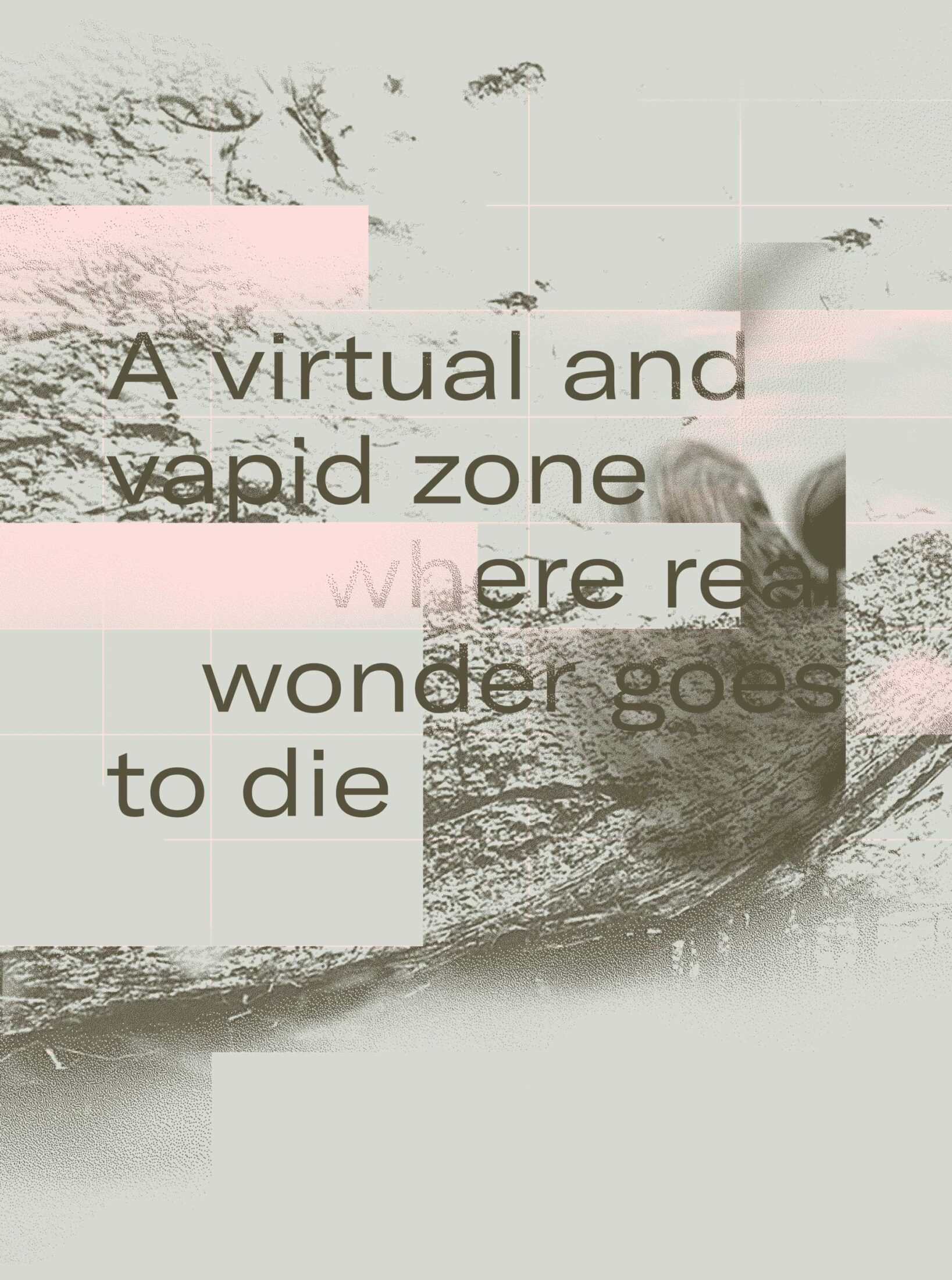
Alphabetic literacy, from this angle, is a kind of magic—a form of animism so intensely concentrated that it has effectively eclipsed all the other forms of participation in which our ancestors once engaged.2 The alphabet and its later ally, the printing press, were the audacious communication technologies that paved the way for the many innovations in electronic interchange that burst upon the scene over the last century and a half, from the telegraph to the radio, from television to the personal computer and the smartphone. If alphabetic literacy can be seen as a concentrated form of animism, let us now ask: How, today, do our new digital technologies make use of, co-opt, or transform the old, instinctive participation between our senses and the sensuous surroundings?
Consider our curious propensity for designing gadgets that talk to us. The first such object I encountered was a talking refrigerator in a friend’s house. The thing had an inbuilt camera that would register each food item that was placed in the fridge, and with face-recognition software it would greet him whenever he opened the refrigerator: “Good morning, Phillip; it’s 6:15!” It would speak up whenever the icebox was too full or needed defrosting, or the lightbulb needed changing. Did my friend need this? I don’t think so. Presumably he could tell that the lightbulb needed changing because the light didn’t come on. But for some reason, he loved it. When I looked it up online, I found a review explaining the practicality of the appliance with this headline: “‘Put the chocolate down!’ The talking diet fridge that keeps your weight in check—the ThinQ Smart refrigerator with an inbuilt dietician.” The company, LG, says that their voice technology “makes communicating with LG’s smart refrigerator much like chatting with a close friend.”
Then, of course, there’s Siri, the humble virtual assistant tucked inside your friendly iPhone. Some folks waste a lot of time trying to have intelligent conversations with Siri. As you might expect, the virtual mind of an iPhone is fairly skilled at math. Try, for instance, asking Siri to divide zero by zero, and you are likely to get a solid but emotionally devastating answer. Soon, however, even the loneliest persons come to realize that the relationship will probably not get very far.
Is it not obvious that by outfitting our devices with “natural language user interfaces,” we are striving to recreate, in a clumsy fashion, something of that old, ancestral sense of living in a world wherein all things have the potential for expressive speech? We’re trying to recreate that magic, but ultimately it doesn’t satisfy. Indeed, it’s a pretty paltry substitute. Because, after all, the only things that now speak to us are our humanly-engineered virtual assistants—like Amazon Alexa or Google Assistant—and their associated appliances. Despite the flimsy gesture toward a kind of magical reality, the fact is that we’re still speaking only to ourselves, to things that we have programmed to talk back to us. And so, after the initial novelty, which maybe lasts about twenty minutes, there’s nothing here that can surprise us, or yield a sense that we’re in communication with beings strangely different from ourselves.
Worst of all, these artifacts talk entirely in words—in fact, they speak our own language: English or French or Chinese. Yet they speak it without any spontaneous affect or feeling. The words come to us not as an expression of how the rectangular intelligence of that refrigerator actually feels (with its shiny exterior and its cool compartments stocked with wilting lettuce leaves and some forgotten pickles, now grown black and fuzzy with mold), but as an endlessly reiterated bodiless monotone that reflects only the monotonous boredom of programmers working in sterile factory spaces. Far from igniting a sense of wonder, these artifacts offer only a sham facsimile of wonder, and speaking with them draws one into an airless space where feeling falls away, a virtual and vapid zone where real wonder goes to die.
Of course, talking objects were only the beginning. The real techno-transformation currently underway is the rapid advent of “ubiquitous computing,” otherwise known as the Internet of Things, or—appropriately for us here—Enchanted Objects. This is the growing trend toward embedding microprocessors in all sorts of everyday objects so those things can communicate with one another, as well as with us. Since these objects will steadily exchange information with the internet, they’ll be able to solve all sorts of problems for us: umbrellas that start glowing when there’s a forecast for rain; doorbells that ring with a different sound for each of the people you know. The big vision animating all this aims to engineer intelligence into the countless things that we already use, not just refrigerators, but bicycles, shovels, garbage pails, curtains—you name it.
And of course, we’ll have wearable technology as well: not just watches and glasses, but clothing with sensors and software built into it, so that you and I become one of the things that are connected to and through the internet to all the other thinking things around us. Like the jacket already designed that gives you a hug every time someone likes your Facebook post. A few years ago, British Airways gave passengers flying from New York to London blankets embedded with neurosensors to track how they were feeling. Apparently this was more scientific than simply asking them. When the fiber optics woven into the blanket turned red, flight attendants knew that the passengers were feeling stressed and anxious. Blue blankets were a sign that the passenger was feeling calm and relaxed. So in this way, the airline learned … what? The company discovered that their passengers were most stressed when the airplane was bouncing around in turbulence, and that passengers were most relaxed when they were sleeping. Eureka!
With sensors embedded in the doors and walls of various buildings, as well as in our clothing, stores will soon recognize us when we walk in, greeting us by name and displaying on our glasses or headsets the many items we most like to buy—or should buy, anyway, because our smart refrigerator at home sends word that we are running low. And with the facial recognition software that’s already being used in China to shame jaywalkers, we’ll soon be able to see, above their heads, the names and pedigree of every person we meet on the street, as well as their criminal record.
Let’s put aside the slight concern that transnational corporations as well as the NSA will thus have access to every facet of our personal lives, since pretty much everything we touch will send data regarding that interaction to the integrated global network of things. And let’s leave aside the inconvenient fact that once our automobiles, our houses, our utilities, and our clothing all become electronically integrated in this manner, various hackers with a modicum of creativity will be able to send whole cities careening into chaos. But is it not apparent that this whole huge trend, ostensibly motivated by the aim for ever-greater convenience and efficiency, is tacitly driven by an impulse to recreate, somehow, the animistic experience common to virtually all of our indigenous ancestors—the experience of living in a fully sentient world, a reality filled with intelligence? To regenerate the experience of inhabiting a world wherein everything is alive, awake, and aware? Wherein rivers feel the presence of the salmon swimming within them, and the ground registers our steps and the needled trees hear our laughter and the crescent moon is nourished by our prayers?
And maybe this attempt to recreate that primal experience of intimacy with the surrounding world will actually succeed. Certainly it’s giving rise to all sorts of fascinating gizmos and whimsical inventions. But it’s also bound to disappoint. The difficult magic of animistic perception, the utter weirdness and dark wonder that lives in any deeply place-based relation to the earth, is the felt sense of being in contact with wakeful forms of sentience that are richly different from one’s own—the experience of interaction with intelligences that are radically other from one’s own human style of intelligence. Yet when interacting with the smart objects that inhabit the always-online world of the internet of things, well, there’s no real otherness there. Of course, there’s the quasi-otherness of the program designers, and of the other people living their own wired lives; although just how other anybody will be when we’re all deploying various forms of the same software (and so all thinking by means of the same preprogrammed algorithms) is an open question. My point, however, is that there’s no radical otherness involved: it’s all humanly programmed, and it’s inhabited by us humans and our own humanly-built artifacts; it’s all basically a big extension of the human nervous system. As we enter more deeply into the world of ubiquitous computing, we increasingly seal ourselves into an exclusively human zone of interaction. We enter into a bizarre kind of intraspecies incest.
Yet it’s the alterity or otherness of things—the weirdly different awareness of a humpback whale sounding its eerie glissandos through the depths, or an orb-weaver spider spinning the cosmos out of her abdomen; or the complex intelligence of an old-growth forest, dank with mushrooms and bracket fungi, humming with insects and haunted by owls—it’s the wild, more-than-human otherness of these powers that makes any attentive relation with such beings a genuine form of magic, a trancelike negotiation between outrageously divergent worlds.
Without such radical otherness, there’s no magic. Wandering around inside a huge extension of our own nervous system is not likely to bring a renewal of creaturely wonder, or a recovery of ancestral capacities. It may keep us fascinated for a time but also vaguely unsatisfied and so always thirsty for the next invention, the next gadget that might finally satisfy our craving, might assuage our vague sense that something momentous is missing. Except it won’t.
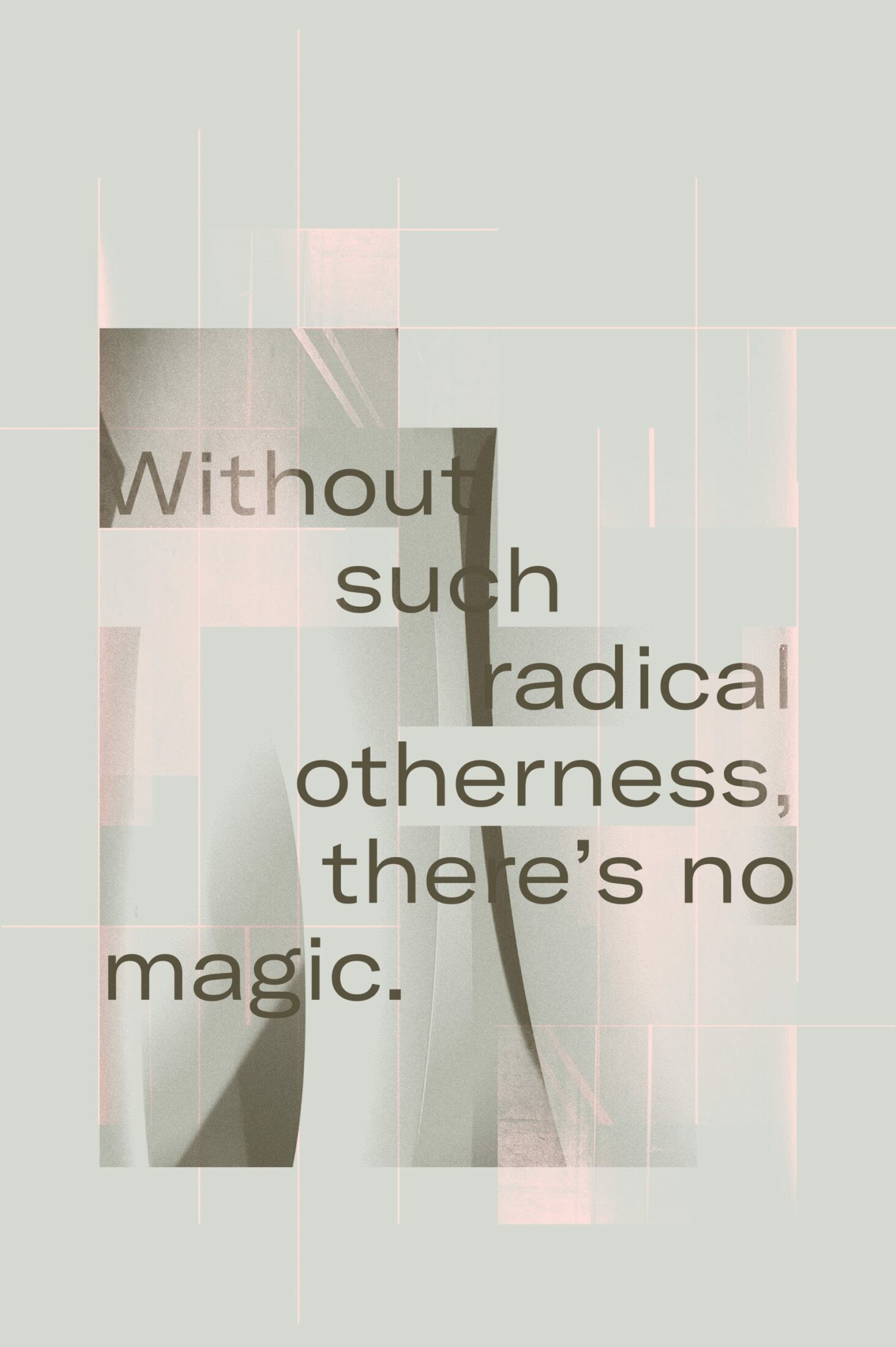
Let’s look closer at one facet of this brave new world that many people already use a great deal: GPS, or the Global Positioning System. Here is a tool that surreptitiously crept into our lives: it is convenient, easy to use, and just happened to come preinstalled within our smartphone—so why not? Without any public or private reflection, cell phone users just began consulting this technology that commonly talks in that soporific voice: “In forty-five yards, turn right onto Forest Glade …”
Few considered what might be lost if we became reliant upon this technology: our capacity to orient in the world. Hence in the space of a little more than a decade, innumerable humans are forfeiting—are short-circuiting—the most ancient and visceral attunement between our animal body and the animate earth, which is our never-entirely-conscious ability to find our way within the local terrain. It’s a skill we inherited from our primate ancestors, handed down to them by the other creatures in our evolutionary lineage, which stretches all the way back to those ancestral fish navigating the ocean depths. Think of the migrating salmon, who somehow, after two or three years in the open ocean, find their way back to the same river, the very same tributary, the very same tiny stream where they were hatched. Consider the profound somatic attunement whereby a salmon feels its way between faint electromagnetic anomalies, riding a particular angle of sun as it filters down through the rippled surface, gliding with certain currents and plunging up against others, dreaming its way through gradients of scent and taste toward a particular bend of gravel and streamside shadow. That’s akin to our own ancestry! Like those fish, like amphibians, like all of our fellow mammals, our bodies have co-evolved with the dynamic shapes and patterns of the breathing earth: our animal eyes are tuned to the earthly rhythms of light and shadow, and our skin to subtle changes in the atmosphere. We are born of this earth and so are primed to be in relation to it; we find our way through the terrain much as a newborn feels its way across its mother’s belly to where the milk fountains forth.
But now, using GPS, we’ve interrupted that old rapport between our bodies and the earthly sensuous. We’re no longer noticing the patterns of the place we are in, registering the sounds and the smells and the shape of various landforms as we pass them—because we’re synapsed to the smartphone, taking directions from a device that’s taking its directions from a complex of thirty-two satellites orbiting the earth twelve and a half thousand miles above our heads! We no longer know where we are anymore without GPS to tell us; indeed, we no longer really inhabit our places, since we spend so much time living via satellite. That is painful, and sad—the forfeiting of something so primal, so precious, so intimately a part of us that we hardly notice it slipping away.
Sadder still, by using GPS we no longer experience the delicious delirium of getting lost in the woods or the mountains. And so we no longer experience the great heightening of our animal senses, the keen synaesthetic attention to the land’s every nuance and subtlety that is triggered by getting lost.
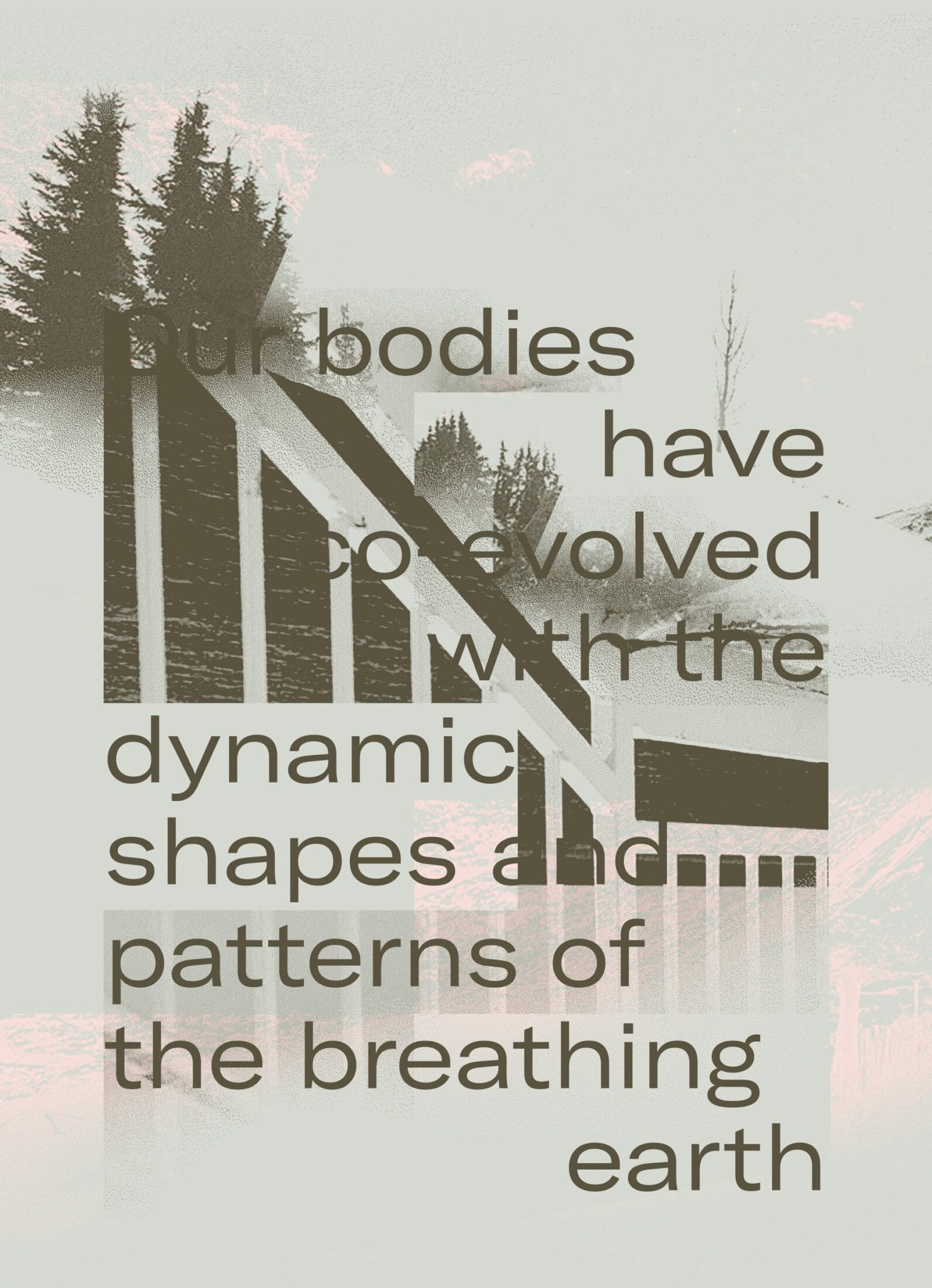
Western navigators, long reliant on a large array of instruments, remain astonished by the ability of traditional seafaring peoples to find their way across the broad ocean by sensing subtle changes in the ocean currents, by tasting the wind and reading the weather, by conversing with the patterns in the night sky. Similarly, many bookish persons find themselves flummoxed by the ease with which citizens of traditionally oral, place-based cultures seem always to know where they are—their capacity to find their way even through dense forests without obvious landmarks—an innate orienting ability that arises when on intimate terms with the ground, with the plants, with the cycles of sun, moon, and stars. GPS seems to replicate this innate and fairly magical capacity, but instead of this knowledge arising from our bodily interchange with the earthly cosmos, here the knowledge arrives as a disembodied calculation by a complex of orbiting and ground-based computers.
In truth, the smartphone itself, which keeps us in contact with other comrades in distant places, mimics a kind of terrestrial attunement that was once our common birthright. Last year, I co-led an expedition into the Kalahari Desert with Jon Young—a legendary tracker and nature educator steeped in several indigenous tracking traditions—in order to learn from a band of San Bushmen who are struggling to preserve many of their traditional hunting and foraging lifeways in the face of relentless “development.” A San elder shared with me his common experience as a young hunter: how upon following the tracks of another creature, he would soon be able to envision the animal’s movements as it laid down those very tracks; and if he kept up this concentration, he might come to feel the prey where it was at the present moment, feeding or sleeping or whatever it was doing at the far end of those tracks. Similarly, Jon Young told me of his own oft-repeated experience in North America, after coming upon the day-old track of an elk, say, or a bear: if he begins to follow the intermittent track, picking it up again and again wherever it leaves off—while also opening his peripheral senses to the sing-song calls and flight patterns of birds, noting the movements of other small animals, sniffing the air and registering shifts in the wind as it rattles the leaves of nearby trees—then it will sometimes happen that he receives, in his mind’s eye, an image of that elk where it is browsing by a stream bend in a distant part of the forest; and if he quietly makes his way to that stream, he will discover the elk just there, at that spot.
There is nothing “extra-sensory” about this kind of earthly clairvoyance. Rather, sensory perception functions here as a kind of glue, binding one’s individual nervous system into the larger ecosystem. When our animal senses are all awake, our skin rippling with sensations as we palpate the surroundings with ears and eyes and flaring nostrils, it sometimes happens that our body becomes part of the larger Body of the land—that our sensate flesh is taken up within the wider Flesh of the breathing Earth—and so we begin to glimpse events unfolding at other locations within the broad Body of the land. In hunting and gathering communities, individuals are apprenticed to the intricate life of the local earth from an early age, and in the absence of firearms, hunters often depend upon this richly sensorial, synaesthetic clairvoyance for regular success in the hunt. The smartphone replicates something of this old, ancestral experience of earthly acumen that has long been central to our species: the sense of being situated over Here, while knowing what’s going on over There.
What is the difference between these two forms of seeing, or sensing, at a distance? One approach, mediated by the smartphone, works by dissolving distance entirely—detaching us from our sensory embedment in a particular place in order to dialogue with other minds that have similarly withdrawn from their senses. The other, in contrast, works by virtue of our body and our creaturely senses. Instead of divesting ourselves of the place where we find ourselves, this more ancient form of clairvoyance involves tuning one’s body so thoroughly to the terrain that we ourselves become fully a part of the sensate surroundings. The land feels itself within us. Our animal body blends into the wider Body of the animate Earth—this immense, spherical metabolism in which our individual physiologies are embedded, upon which our divergent lives all depend.
Perhaps it is easier to understand, now, why we’re so enthralled by our digital technologies, such that once we’re online and synapsed to the screen, it’s remarkably difficult to tear ourselves away. For all these technologies awaken something primordial in us, a biophilic proclivity layered deep in our genome, a penchant for animate interchange with bodies whose shapes are very different from our own. The renewal of that age-old animistic sense of a world all alive, awake, and aware brings an upwelling of wonder, or at least an anticipation of a wondrous possibility waiting just around the corner. And so we remain transfixed by these tools, searching in and through our digital engagements for an encounter they seem to promise yet never really provide: the consummate encounter with otherness, with radical alterity, with styles of sensibility and intelligence that thoroughly exceed the limits of our own sentience. Yet there’s the paradox: for the more we engage these remarkable tools, the less available we are for any actual contact outside the purely human estate. In truth, the more we participate with these astonishing technologies, the more we seal ourselves into an exclusively human cocoon, and the more our animal senses—themselves co-evolved with the winds, the waters, and the many-voiced terrain—are blunted, rendering us ever more blind, ever more deaf, ever more impervious to the more-than-human Earth.
Which brings us, finally, back to our initial question: What is the primary relation, if there is any actual relation, between the two contrasting collective moods currently circulating through contemporary society—between the upbeat technological optimism coursing through many social circles and the mood of ecological despondency and grief that so many other persons seem to be feeling? As a writer who uses digital technology, I can affirm that these tools are enabling many useful, astounding, and even magical possibilities. But all this virtual magic is taking a steep toll. For many long years this techno-wizardry has been blunting our creaturely senses, interrupting the instinctive rapport between our senses and the earthly sensuous. It’s been short-circuiting the spontaneous reciprocity between our animal body and the animate terrain, disrupting the very attunement that keeps us apprised of what’s going on in our locale—the simple, somatic affinity that entangles our body with the bodies of other creatures, binding our sentience with that of the local earth. Today, caught up in our fascination with countless screen-fitted gadgets, we’re far more aloof from the life of the land around us, and hence much less likely to notice the steady plundering of these woodlands and wetlands, the choking of the winds and the waters by the noxious by-products of the many industries we now rely on. As these insults to the elemental earth pile up—as the waters are rendered lifeless by more chemical runoff, by more oil spills, by giant patches of plastic rotating in huge gyres; as more glaciers melt and more forests succumb to the stresses of a destabilized climate—the sensorial world of our carnal experience is increasingly filled with horrific wounds, wounds that we feel in our flesh whenever we dare to taste the world with our creaturely senses. It’s too damned painful. Hence there’s ever more reason to retreat from the body’s world, to avoid the sensuous terrain with its droughts and its floods and its flaring wildfires, taking refuge in ever more mediated and virtual spaces. Thus do we render ourselves ever more numb. Ever more deaf to the anguished cries of other creatures, ever more oblivious to the vanishing of species, ever more inured to the steady flattening of the Real. Ever more calloused and closed to the shuddering pain of the biosphere, breathing.
- I use the term “animism” broadly, here, to refer to the perceptual style common to many indigenous, oral (or non-writing) cultures, whose discourse simply does not bear any hard and fast distinction between presences that are animate and others that are inanimate.
- The argument briefly sketched here is laid out with far more care, and an abundance of evidence, in the fourth chapter of my book The Spell of the Sensuous, entitled “Animism and the Alphabet.” See David Abram, The Spell of the Sensuous: Perception and Language in a More-than-Human World, Vintage Books, 1997, pp. 93–136.

